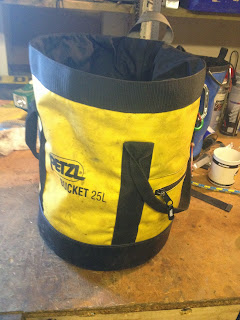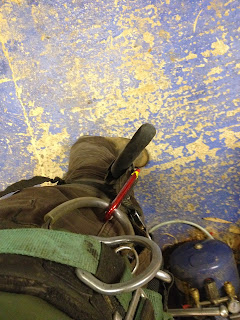"a place for everything and everything in its place"
And these Petzl bucket bags fit the bill quite nicely as you can see.
I've got 2 of the 35lt bags, one for the rigging line/block and dead eye sling and one for the arial rescue kit. So they will happily take 60m of 16mm line or 30m of 13mm, a harness, strop, spikes etc…
Then i have a few of the 25lt bags for tag lines, porta wrap, speed line stuff and other general lowering equipment.
I also have one that goes out with me every work day regardless of task, this one contains full water proofs x2, sharpening kit, mini tool kit, first aid kit, felling wedges, spare tee shirt and I'm sure theres some other stuff in there as well. This one is going on for 3 years old now and has been fairly well abused but is holding its own pretty well.
I think that says a lot for the construction of these bags, they are pretty bomb proof. with a reinforced base and a thick waterproof outer they keep everything nice and dry from the ground up. They only have a drawstring top so are not rain proof but do keep out the worst of it. Both sizes have a shoulder strap and two heavy duty carry handles that flop to the side when not in use, you can see these are stitched all the way down the side to the base so are not going to fall off in a hurry.
When it comes to using these as an actual rope bag they are brilliant and work exactly as a rope bag should. they are rigid enough to stand up when empty, making spoiling the rope back in easy, the drawstring top is big enough to fold down over the outside so its completely out of the way.
A nice touch that a lot of rope bags seem to miss out on. And if leaving at the base of the tree the top can be synched up to stop dirt/sawdust filling the bag and still the rope will pull out nicely.
The bags also have a clear window on the outside for labelling, and a small zippered pocket on the outside. Yet to find much of a use for this as its quite small and fairly awkward to get into if the bag is full.
There is also a small haul loop on the top of the bag and a small one inside, this one
I find quite useful for tying the end of the line to, making it much easier to find.
This is the only gear loop on the inside of the bag, so some might say it lacks some of the features of the other bags on the market, but I don't think that detracts from the use of the bag and I'm not a massive fan of having kit hanging off the bag anyway, as i think its a good way to loose stuff.
So all in all a bomb proof bag that does what it says on the tin very well. But could potentially benefit from some internal/external gear racking. But for £25 - £35 you will struggle to get any better.

















